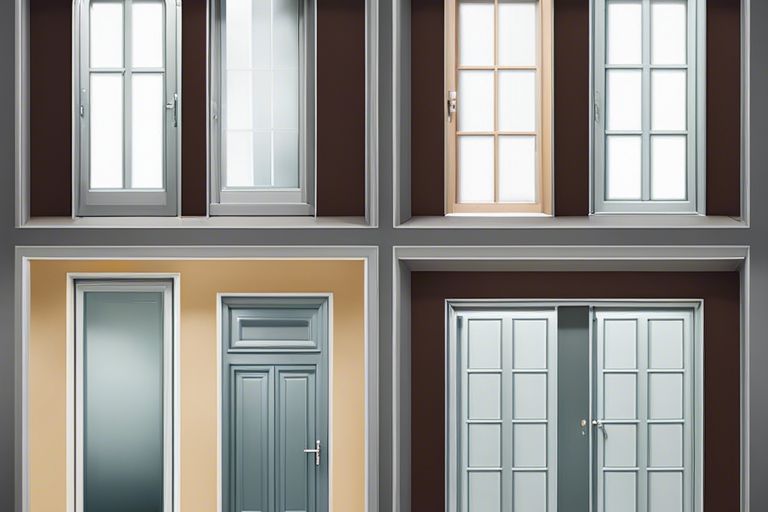You may have noticed condensation forming on your windows and doors, especially during the colder months. This is not only an annoyance, but it can also lead to mould growth and damage to your property. If you have aluminium windows and doors, you may be wondering if they are contributing to this issue. In this blog post, we will explore the potential factors that make aluminium windows and doors more prone to condensation, as well as strategies you can use to prevent it. Stay tuned to learn how you can keep your home free from condensation and its harmful effects.
Key Takeaways:
- Aluminium windows and doors can contribute to condensation in the home due to their conductive nature, which can cause the surfaces to become colder and attract moisture from the air.
- Proper insulation and ventilation are crucial to prevent condensation when using aluminium windows and doors. Good insulation helps to maintain the temperature of the surfaces, while adequate ventilation helps to remove excess moisture from the air.
- Regular maintenance and care of aluminium windows and doors can also help to mitigate condensation issues, ensuring that seals are intact and any moisture build-up is promptly addressed.

The Nature of Condensation
Condensation in your home is the result of excess moisture in the air coming into contact with colder surfaces, such as windows and doors. This can lead to a range of issues including damp, mould, and potential damage to your property.
How Condensation Forms
Condensation occurs when warm, moist air comes into contact with a cooler surface, causing the air to release its moisture in the form of water droplets. This often happens on windows and doors, where the surface temperature is lower than the surrounding air.
Factors Influencing Indoor Condensation
Several factors contribute to the level of condensation in your home. These include indoor moisture levels, temperature differentials, and ventilation. If your home has high humidity levels, a significant temperature difference between indoor and outdoor environments, and inadequate ventilation, you are likely to experience increased condensation.
- Indoor moisture levels: Cooking, washing, and drying clothes indoors can contribute to high levels of moisture in the air.
- Temperature differentials: Sudden changes in temperature, especially between indoor and outdoor environments, can lead to condensation.
- Ventilation: Poor ventilation means that moist air becomes trapped inside your home, increasing the likelihood of condensation forming on windows and doors.
Assume that addressing these factors is critical in preventing condensation-related issues in your home.
Aluminum Windows, Doors, and Condensation
When it comes to understanding the factors contributing to condensation in your home, it’s essential to consider the type of windows and doors you have installed. Aluminum windows and doors are popular choices for many homes, but they can also play a role in creating condensation issues. In this chapter, we will delve into the relationship between aluminum windows, doors, and condensation to help you better understand how to manage this common household problem.
Thermal Conductivity of Aluminum
Aluminum is a highly conductive material, meaning it readily transfers heat. This can lead to the formation of cold spots on your windows and doors, which in turn can contribute to condensation. When the warm air inside your home comes into contact with the cold aluminum frames, it cools down quickly, causing moisture in the air to condense on the surface of the frames. This can result in water droplets forming and running down the windows, potentially leading to other issues such as mould and damp.
Design and Installation Issues Affecting Condensation
The design and installation of aluminum windows and doors can also impact the likelihood of condensation occurring in your home. Poorly fitted windows and doors can create gaps through which warm, moist air can escape, coming into contact with the cold aluminum surfaces. Additionally, inadequate sealing or insulation around the frames can exacerbate the problem, allowing moisture to build up and lead to condensation issues. It’s important to ensure that your aluminum windows and doors are installed correctly to mitigate these potential issues.
Mitigating Condensation with Aluminium Products
When it comes to combating condensation in your home, aluminium windows and doors can play a crucial role in helping to alleviate this problem. While condensation can occur on any type of window or door, aluminium products are specifically designed to offer better insulation and reduce the likelihood of condensation forming. To find out more about how aluminium windows can help with condensation, you can read this Ultimate Guide of Windows Condensation – Oridow.
Advancements in Aluminium Window and Door Technologies
Advancements in aluminium window and door technologies have led to the development of highly insulating window frames and efficient sealing mechanisms. This means that aluminium products are better equipped to prevent the formation of condensation. By using thermally broken aluminium frames and high-performance glazing, you can significantly reduce the risk of condensation in your home. These advancements have made aluminium windows and doors an excellent choice for homeowners looking to mitigate condensation.
Best Practices for Reducing Condensation
When it comes to reducing condensation in your home, there are some best practices that you can implement. Firstly, ensure that your home is adequately ventilated to allow moisture to escape. Additionally, using aluminium windows and doors with advanced insulation properties can help to minimise the formation of condensation. Regularly monitoring the humidity levels in your home and addressing any potential sources of excess moisture can also help in preventing condensation. By following these best practices, you can effectively reduce the risk of condensation in your home.
Comparative Analysis
When it comes to preventing condensation in your home, it’s important to consider the material of your windows and doors. Aluminium is often compared to other materials in terms of its ability to resist condensation. According to Aluminium Bifold Doors, aluminium windows and doors are less prone to condensation than other materials such as wood or uPVC. Let’s take a closer look at how aluminium compares to these materials:
| Material | Condensation Resistance |
| Aluminium | Less prone to condensation due to its thermal performance |
| Wood | More susceptible to condensation as it is a natural insulator |
| uPVC | Can experience condensation due to its lower thermal performance |
Aluminum versus Other Materials in Preventing Condensation
When it comes to preventing condensation, aluminium outperforms other materials such as wood and uPVC. This is due to its superior thermal performance, which helps to reduce the likelihood of moisture build-up on your windows and doors. If condensation is a concern for you, opting for aluminium frames may be a wise choice.
The Role of Ventilation and Insulation in Combating Moisture
While the material of your windows and doors plays a significant role in preventing condensation, it’s also important to consider the role of ventilation and insulation in combating moisture. Effective ventilation helps to circulate air and reduce humidity levels in your home, while proper insulation can prevent cold spots that often lead to condensation. By ensuring adequate ventilation and insulation, you can further reduce the risk of condensation on your windows and doors.
Conclusion
Now that you have gained a comprehensive understanding of the role of aluminium windows and doors in contributing to condensation in the home, you can make informed decisions about your choice of materials for your property. While aluminium itself does not cause condensation, it is important to consider the type of window and door frames you choose, as well as the quality of installation and insulation. By considering these factors, you can mitigate the risk of condensation in your home and ensure a comfortable living environment.
Aluminium Windows and Doors FAQ
Q: Do Aluminium Windows and Doors Contribute to Condensation in the Home?
A: Aluminium windows and doors can contribute to condensation in the home if they are not properly installed or insulated. Poorly fitted aluminium windows and doors can create gaps that allow warm moist air to come into contact with the cold surfaces, leading to condensation. However, with proper installation and insulation, aluminium windows and doors should not significantly contribute to condensation issues.
Q: How can I prevent condensation with aluminium windows and doors?
A: To prevent condensation with aluminium windows and doors, ensure they are correctly installed to eliminate any gaps. Additionally, using double or triple glazing and thermal break technology can help to improve insulation and reduce the potential for condensation to form.
Q: Are aluminium windows and doors more prone to condensation than other materials?
A: Aluminium windows and doors are not inherently more prone to condensation than other materials. Proper installation, insulation, and ventilation are key factors in preventing condensation, regardless of the material used.
Q: Can condensation with aluminium windows and doors lead to mould and mildew growth?
A: Yes, if condensation is not addressed, it can result in mould and mildew growth on and around aluminium windows and doors. This can potentially damage the surrounding walls and compromise air quality in the home. Proper ventilation and moisture control are essential in preventing this issue.
Q: How do I know if my aluminium windows and doors are contributing to condensation?
A: Signs of condensation issues around aluminium windows and doors include water droplets on the glass or frames, dampness around the window or door, and potential mould and mildew growth. If you notice these signs, it’s essential to address the issue promptly.
Q: Can I retrofit my existing aluminium windows and doors to reduce condensation?
A: Yes, it is possible to retrofit existing aluminium windows and doors with improved insulation, seals, and glazing to reduce the potential for condensation. Consult with a professional to determine the best course of action for your specific situation.
Q: Are there any specific maintenance tasks for aluminium windows and doors to prevent condensation?
A: Regularly checking and maintaining the seals, weather-stripping, and insulation around aluminium windows and doors is essential to prevent condensation. Additionally, ensuring proper ventilation throughout the home can help to reduce the likelihood of condensation forming on these surfaces.






